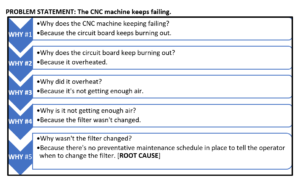This week’s tip continues discussing the Analysis phase of FRACAS, and we’ll focus on some of the analysis tools that can be used to help determine the root cause. A key point to remember from last week’s tip is to ensure that you have the problem (failure incident) well defined. Remember, the quality of the analysis depends heavily on the quality of the problem definition. It should be short, simple and easy to understand.
Below is a list of tools along with situations where they can typically be used effectively. Some can be used for both process-related and equipment-related failure incidents. The below is not an exhaustive list of analysis tools, just some of the ones I’ve found to be the most effective over the years. There are a number of references that can be found online for a more in-depth look at these tools.
Brainstorming – This is a technique I’ve always used and found to be effective for both process and equipment failures. If the problem warrants a team-based approach, the key is to ensure that: all team members participate; none of the potential causes are criticized or dismissed on the first pass; you build on other team member ideas. The point is to get all team members to participate and to get a list of potential causes. The key to brainstorming is quantity, not quality. Set a time limit when using this technique. Typically, an one-hour session is sufficient. During the next session, the focus should be on eliminating duplicates, and narrowing and categorizing the list of potential causes. Organize the potential cause into three (3) categories: Immediate, Contributing and Root. This session should typically take 2 – 3 hours to complete.
5 Whys – Another effective technique for both process and equipment failures. The technique is essentially what its name implies: ask “Why” five (5) times. But in actual practice, it can require more or less than five. By asking the question “Why”, you’ll be able to separate the symptoms from the causes. The answer to the first “Why” will uncover another reason (or symptom) that leads to the next “Why”, and so on. See Figure 1 and 2 below for simplified examples.

Figure 1: Simplified 5 Whys example showing a single path to a single root cause

Figure 2: Simplified 5 Whys example showing multiple paths to different root causes
Figure 2 illustrates that there can be more than one branch to a “Why” question. The beauty of this technique is that it’s:
- Simple: relatively easy to use and doesn’t require any advanced math or tools.
- Effective: When done correctly, it separates the symptoms from the causes. A key risk in performing any RCFA is treating the symptoms rather than causes.
- Comprehensive: This technique can easily depict the relationships between various causes.
- Flexible: It works well with other analysis tools.
- Engaging: It fosters and produces communication and teamwork.
- Inexpensive: The only investment is the teams’ time.
In next week’s tip, we’ll continue discussing some of the other Analysis tools that can be used to determine the Root Cause.
© 2017 by LinRich Solutions, LLC. All rights reserved


